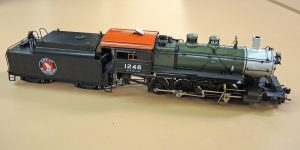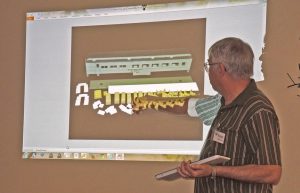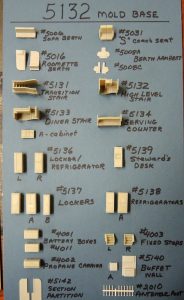Article and Photos by Rich Thom
The Skagit Valley & Whidbey (SV&W) NMRA Clinic’s November meeting, held on Nov. 9th at the group’s Summerhill venue in Oak Harbor, attracted 24 participants and rewarded all with a diverse evening of both prototype and model railroading. The clinic included a detailed look at the products of new clinic member Mark Malmkar, who with wife Chris recently moved from Nebraska to the Pacific Northwest – quite a transition for sure! – to be closer to family who had gravitated to this corner of the country.
“Show and Tell” was thin this evening. Come on, people, bring in your projects, whether completed, work-in-progress, or just planned! Dave Clarke continued what is nearly a monthly tradition by modestly displaying his latest masterwork: the GN Class F8 Consolidation shown in Fig 1. It’s a Tenshodo brass import which Dave upgraded with DCC and sound (although the model didn’t need swapping out motors as often done). It was factory-painted but (of course!) not perfect enough for Dave, who completely stripped the model and repainted with the result you can judge for yourself in Fig 1. Absolutely beautiful work.
For a number of years when our clinic group was smaller, John and Valerie White hosted each December in place of the usual clinic meeting a Wassail celebration at their home in Anacortes, featuring not only holiday food and drink but also a more-casual-than-usual operating session on John’s On30 layout. The clinic attendance has ballooned such that this tradition is no longer practical, but at our December meeting (Dec. 14th) we will attempt to recreate the Wassail on a larger scale at the Summerhill facility. All attendees are urged to bring a potluck dish to share. The evening’s program will be a slide show (we really mean slides, those pieces of actual film mounted in cardboard frames, if anyone remembers) of a circa-1985 adventure that John made in the company of other rail industry professionals all around Europe, including both railroading and conventional “touring”. The December meeting will begin a half-hour earlier at 6:30 pm, and significant others (in addition to those who regularly attend) are encouraged to join us.
Susan Gonzales (speaking for Contest Shepherd Phil Gonzales) reminded everyone of this season’s contest theme: Telling a story in 24 square inches. Entries can be any scale, any height (or depth) so long as the footprint of the mini-scene does not exceed 24 square inches. Judging will be done at the February meeting, so: Modelers get busy!
Next up, Al Frasch enjoyed a month-long holiday in Scotland and London this summer and presented a brief photo essay of his trip. Al included shots of the Firth of Forth Bridge (there’s so much iron in this monster that when painters finish painting at the far end, they have to go back to the other end to start all over again); the North Deeside Railway; the Strathspey Steam Railway; Oban; the Bo’Ness and Kinneil Railway; Edinburgh’s Waverley Station (with some nicely-complex slip switches at the terminal throat); London’s “Tube” (you can go anywhere with complete ease, says Al); and to Windsor on the Southwest 3rd-rail electrified network. At Windsor the Queen was “in” but Al didn’t reveal if he had an audience. Thanks, Al, for providing a reminder that the UK has a great deal to offer visiting railfans.
Then to the main program for the evening. Mark Malmkar presented a 3-part talk with some Nebraska prototype scenes to start, transitioning to many Nebraska layouts he contributed to as well as his own home layout, finally segueing to a detailed description of the manufacturing processes and products of his own company, Palace Car Co., located on the web at http://www.palacecarco.com.
Mark showed photos of several layouts he helped build, including the Tri-Cities Model RR Association (TCMRA) layout – the Tri-Cities refer to Grand Island, Hastings, and Kearney in Nebraska. This reporter was especially intrigued by an enormous helix assembly built entirely of steel in a local shop (it was so heavy it was rolled into the layout building like a tire) and another helix uniquely disguised as a water tank. Mark also built modules for a club which set up a modular layout on the county fairgrounds that was 140 feet in length. Perhaps most creative of all, Mark and his club built a diorama for a local children’s museum. That in itself isn’t special, but this was: the diorama was rotated seasonally. Three identical dioramas were built — all incorporating the same structures and trackwork — but the scene foliage and details were varied with the season: spring/summer; fall; and winter. In the fall scene, a pumpkin market occupied a lot; in the winter scene, Christmas trees were on sale in the same space. Clever, inviting visitors to return again and again.
Mark showed photos of his home layout in Kearney, the Rocky Mountain Central Railroad, a double-deck HO-scale layout which had been about one-half completed and occupied a space of about 14 x 40 feet. Fortunately, Mark planned ahead and the layout was entirely built in modular form, and is currently safe in a storage unit until it can be reassembled in Mark and Chris’ Oak Harbor home, where (conveniently!) a 28 x 40 foot space is available. Our clinic is eagerly looking forward to the first open house! (No pressure, Mark.)
“Are you tired of your coaches having that dark, empty look?” That’s the motto of Mark’s Palace Car Co. In the 1980’s, Mark wanted interiors for some of his coaches so he first milled seats from oak; they were finely crafted for sure, but there had to be a better way. There was: injection molding, and Mark decided to turn car interiors into a business. In 1999, the Palace Car Co. brand of products was founded.
The result today is a large line of interior kits, of which just a small selection is shown in Figure 2, a few of the promotional posters that Mark employs at train shows.
Mark shared some details of the economics of such an endeavor. The injection molding process requires expensive molds, either entirely steel or aluminum with steel inserts, and their cost can run into the thousands – $11,000 for one example Mark cited. And they don’t always work as designed. Mark described one troublesome mold which repeatedly produced parts with holes in the bottom seat cushions, resulting in a curious part indeed: was it a seat, or a toilet? The obvious gamble is: Can I recover my up-front capital with sufficient sales of the parts produced?
Mark’s enterprise has been successful by offering a huge catalog of kits and parts for all of the major passenger car manufacturers including IHC, Train Station Products, Roundhouse, Rivarossi, Con-Cor, Athearn and others. A typical kit, an example shown in Fig 3, contains bulkheads, seats, berths, counters, lockers, refrigerators, stairways etc. all depending on the type of car. Also visible in Fig 3 is the car weight supplied with the kits, a steel insert to which the interior components can be securely glued, and which weights each car to NMRA standards and spreads the weight out evenly.
Figure 4 shows the parts produced by one particular (no. 5132) mold base. Those illustrated are injection molded parts. Mark also produces resin castings (although he didn’t bring any examples to display this evening), a viable alternative for smaller part runs of less than 1,000 pieces, the break point in Mark’s experience.
Thanks to both Al Frasch and Mark Malmkar for a thoroughly interesting evening.





No Comments Yet